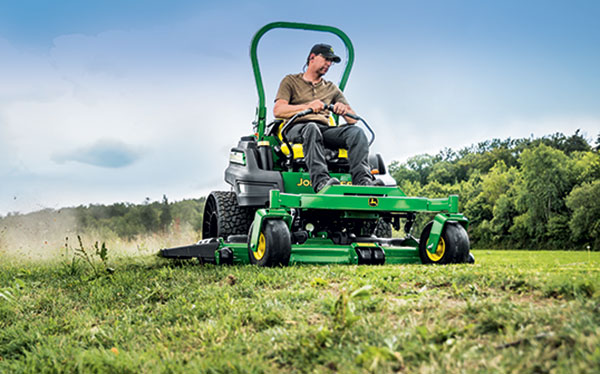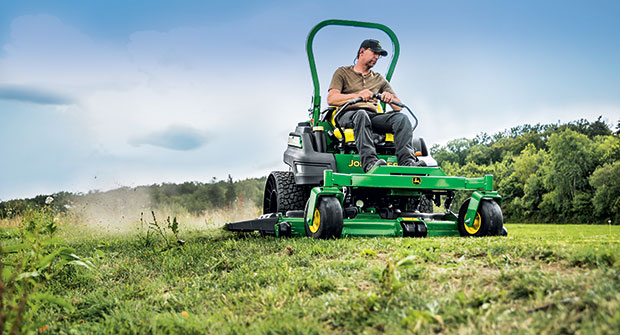
In their constant pursuit of job site efficiency, maintenance crews shouldn’t lose sight of the fact that safety and quality are equally important. To that end, even the most seasoned zero-turn mower operators need a refresher training from time to time — especially after a long off-season.
“Operators should keep an eye on their tires,” says Roger Beale, a branch manager for Greenscape in the Raleigh, N.C., market. “If operators are noticing water and mud, they are likely causing landscape damage. They should stop mowing and assess what is going on. And, if they ever get stuck, they should be trained to back the mower up as opposed to powering it forward.”
Knowing one’s working conditions is also important. Certain mower accessories make knowing the surroundings even more important. At Greenscape, operators pay special attention to rear-mounted debris catchers, which can lengthen a zero-turn mower by as much as one-third.
“Since our operators are used to mowing without a catcher, they can forget how to make turns,” Beale says. “Every fall, when we put the catching systems on, we have a training session. We set up an obstacle course with safety cones to let our operators practice.”
Rollover protection system (ROPS) bars can create similar operator issues. Beale says Greenscape employees are continually reminded to account for the full height of the mower — ROPS included — when attempting to mow under trees and other obstacles.
Speaking of ROPS, some operators like to collapse them so they don’t have to worry about mowing under trees. But as Beale points out, “The manufacturers put them on for a reason.”
Ivan Giraldo, president of Clean Scapes based in Austin, Texas, couldn’t agree more. His equipment managers install bolts in place of the standard safety pins, preventing operators from collapsing the ROPS.
Clean Scapes also takes steps to minimize mower wear and tear.
“We train our employees to avoid curbs when possible, looking for a sidewalk entrance into the turf area instead,” Giraldo says. “It is important for leadership to stress the importance of this because operators are also trying to do their jobs efficiently and not waste time.”
That is because productivity, safety and quality must always go hand in hand.
Experts from four zero-turn mower manufacturers offer some additional insights on the common mistakes zero-turn mower operators make.

Exmark
Mike Mayfield
Product manager
One mistake we see landscape professionals make is basing purchase decisions on price alone. Efficiency, productivity, operator comfort, durability and total cost of ownership are equally important factors. Contractors should consult with their local dealership to explore the features and options that make the most sense in each application. The right mower will allow an operator to finish jobs faster, easier and more profitably. Because of this, the increased upfront costs are paid back with interest over the life of the mower. The last time a contractor worries about purchase price is when they sign the purchase agreement. From that moment on, the focus shifts to productivity, efficiency and making money. That’s where you see the value of choosing the right mower for the job.

John Deere
Ruben Peña
Product marketing manager
One common mistake zero-turn operators make is mowing at a machine’s top transport speed. Operators should mow at a speed that is appropriate for the length of grass being cut, the landscape and the conditions. This is especially important when mulching. Another common mistake is choosing the wrong height of cut. Most machines have a cut height range of 1 to 5 inches. This range allows operators to adjust for various factors such as grass type, mowing conditions, mowing speed and seasonality. By performing all manufacturer-suggested routine machine maintenance, mowing at an appropriate speed and selecting the right height of cut, operators can improve overall cut quality and enhance their productivity.

Husqvarna
George Reister
Global product manager – ZTR
All professionals know it is important to sharpen blades on a regular schedule, but many forget that it is also critical to check tire pressure on all four tires. A partially flat tire will throw off the pitch and level of the deck, resulting in an uneven cut. On that note, always recheck deck pitch and level after a tire change or other major repair. With new operators, it is best to start off their training on pavement. When they can maneuver confidently at the right speed without squealing the tires, they are ready for grass. This helps ensure that they have learned to avoid “dead sticking” turns. Holding the inside tire while still turning is the primary cause of turf damage for newbies.

Kubota
Tom Vachal
Senior turf product manager
There are two key things commercial cutters should focus on in the beginning of the season. The first is to make sure all equipment is ready by doing things like adding fresh fluids, inspecting belts for failure points and verifying that all switches are working properly. The second is to ensure that employees are trained properly. Hold a session with all new employees to make sure they know how to operate and perform simple inspections on all equipment. Also, let both new and returning employees know how your company operates and what the expectations are. These employees will be your brand ambassadors, and their work is a direct reflection of your company. This is important because the competition for customers is getting more difficult.


